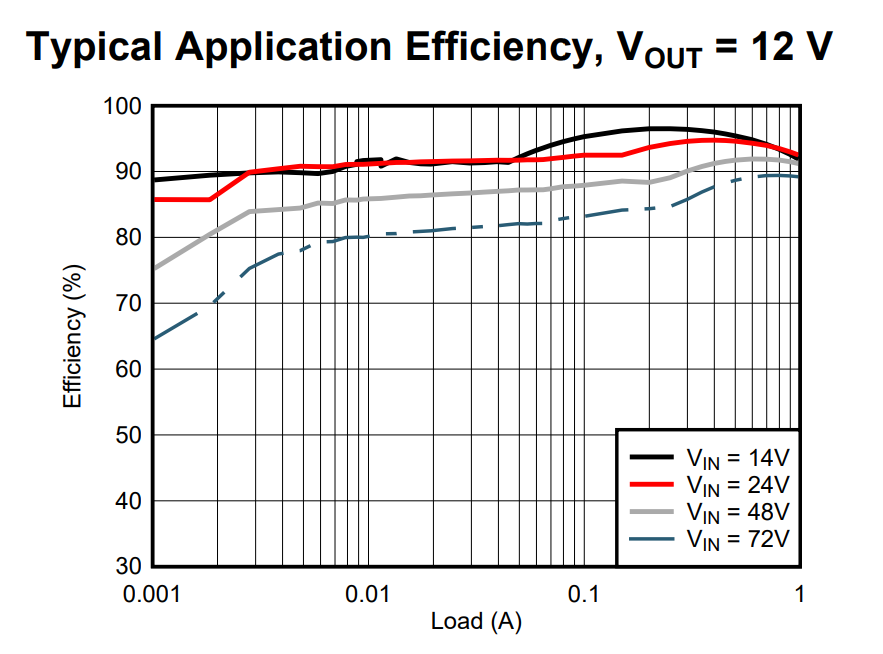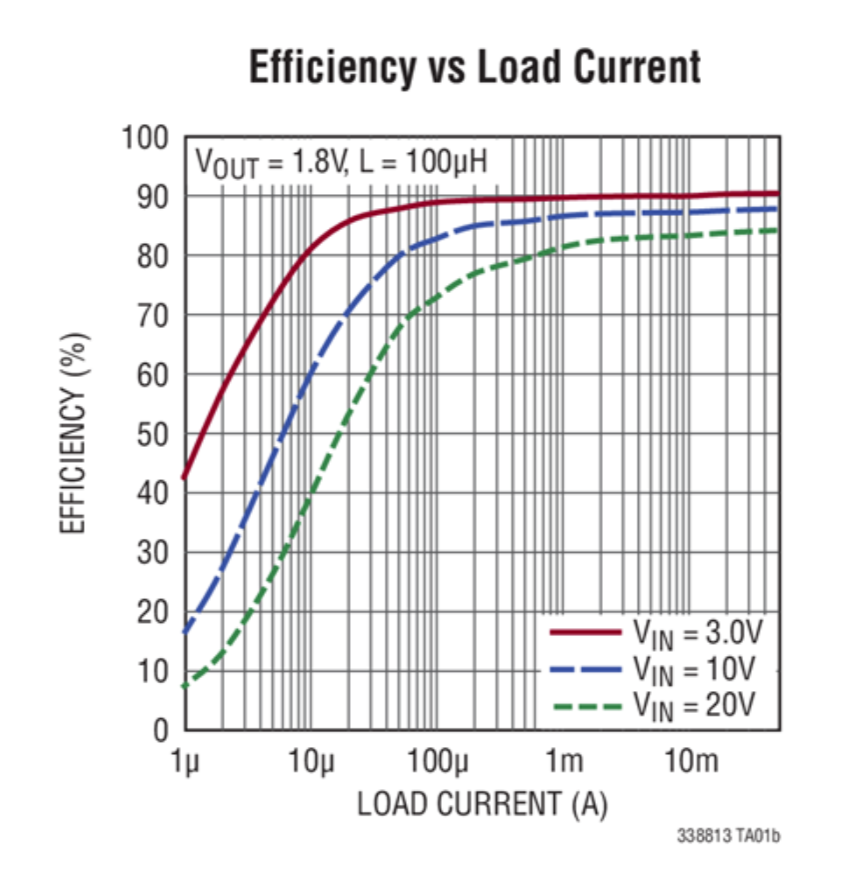Solar Energy Harvesting for wireless motes
-
I notice that TI has a relatively new buck converter chip, the LM5164. In comparing it to other buck converters, what stands out about it is that it has high efficiency, even at a load current of just a milliamp:

So, at least that much is impressive. However, its active current is 600-880ua, which is through the roof compared to the LTC3388, which is what led me to search for an alternative buck converter in the first place. The only way I can see to make use of it would be in very short bursts, which it fortunately seems designed to manage.
So, for that reason, for now I'll stick with the LTC3388 and leave the perfecting of the buck converter as a future optimization...
-
So, this smoking gun more or less settles it the matter regarding the LTC3388:

Because of low efficiency at the microamp range, neither would appear to be a good match for solar cells extracted from the key fobs. Nonetheless, it would be a good match for higher current solar cells.
-
I hadn't been aware of it until now, but apparently there do exist batteries with a very low 0.7% annual self-discharge rate, which translates into still having 70% of their original capacity a full 40 years later! http://www.tadiranbat.com/assets/white-paper-for-sensors-online-revised.pdf They're fairly pricey, but do they seem like a much simpler method for getting past the cold-start problem on most energy harvesters. Presumably nearly all motes would be obsolete after 40 years anyway, and probably even long before that.
-
Looks as though the EM8500 solar energy harvester can still function even if fed a current of just 1ua, for a total of 1uw power, and perhaps even less: https://www.emmicroelectronic.com/sites/default/files/products/datasheets/8500-ds.pdf
If I'm not mistaken, that's lower power than any other chip! And if it's price really is $2.30 for quantity 1, then that would make it one of the least expensive energy harvester chips as well.
Unfortunately, neither digikey nor mouser carry it.
-
Intended for TEGs instead of photovoltaic, the EM8900 is nonetheless impressive. According to its datasheet, it can both cold start and operate with an input voltage as low as 5mv. That's far and away better than the LTC3108, which before now I had thought was the world leader with its 20mv minimum operating voltage. https://www.emmicroelectronic.com/sites/default/files/products/datasheets/8900-ds.pdf
-
Intended for TEGs instead of photovoltaic, the EM8900 is nonetheless impressive. According to its datasheet, it can both cold start and operate with an input voltage as low as 5mv. That's far and away better than the LTC3108, which before now I had thought was the world leader with its 20mv minimum operating voltage. https://www.emmicroelectronic.com/sites/default/files/products/datasheets/8900-ds.pdf
-
@NeverDie can't you order from https://www.cdiweb.com/products/detail/em8500a001lf24b-em-microelectronic/594464/ ?
@mfalkvidd Yup. It was when looking there for the EM-8500 that I first noticed the EM-8900 (just 79 cents, quantity one!).
-
cough cough , so much dust here in the archives... ;)
@NeverDie SPV1050 is what you are looking for, only Maximum Power Point Tracking IC from all IC's you mentioned/tested in both your topics. And trust me, it makes a whole world of a difference. ST even have online component calculator for matching it to solar panel and battery used. My usage scenario was outdoor rechargeable coin cell battery and calculator solar cell. Only drawback: you have to determine maximum power point of your solar cell.
-
cough cough , so much dust here in the archives... ;)
@NeverDie SPV1050 is what you are looking for, only Maximum Power Point Tracking IC from all IC's you mentioned/tested in both your topics. And trust me, it makes a whole world of a difference. ST even have online component calculator for matching it to solar panel and battery used. My usage scenario was outdoor rechargeable coin cell battery and calculator solar cell. Only drawback: you have to determine maximum power point of your solar cell.
@Sasquatch Cool! How did you wire yours up? Did you use an eval board of some kind, or did you do something custom? I actually have one of these:
https://media.digikey.com/pdf/Data Sheets/DFRobot PDFs/DFR0579_Web.pdf
but I hadn't gotten around to testing it. So, thanks for the feedback! Now I have a reason to try it sooner rather than later.Looks as though the setting of the "MPPT" may be similar to how the LTC3105 does it:
https://www.openhardware.io/view/281/Solar-Energy-Harvester
It's not really MPPT, though, so Linear Technology calls it MPPC instead.
